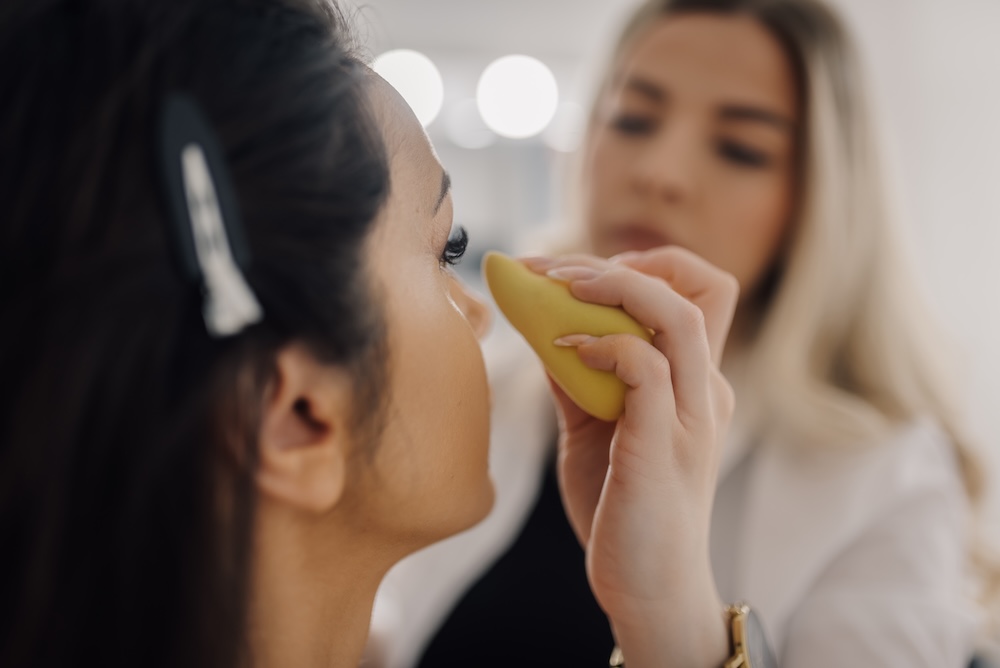Winter skin can be stubborn – but with smart prep, layered hydration and flexible base choices, makeup artists can create smooth, long-lasting results even on the driest days
A practical guide to winter proofing client skin so makeup looks smoother, lasts longer, and feels comfortable through every party and event.
Why winter skin changes makeup application
Winter isn’t kind to skin, and every makeup artist knows it. Cold air outside and central heating inside create a mix of dryness, tight patches and general dullness that make makeup harder to work with.
Even clients who usually sail through the year without issues can arrive with flakiness around the nose, uneven cheeks or that slightly tight look winter skin gives.
When you’re trying to create a smooth, long-lasting finish for a night out, these things matter.
A few small adjustments in prep and product choice can make the difference between a base that sits beautifully and one that fights you all evening.
Winter skin prep that makes makeup last
Cleanse gently to remove dryness without stripping
Good prep is essential in winter, but it doesn’t need to be complicated. A gentle cleanse gets rid of the dryness that comes from cold air and heating. Cream or gel cleansers tend to leave the skin more comfortable.
Layer hydration for softer, smoother texture
Hydration works better in layers than in one heavy hit. A light serum followed by moisturiser gives the skin something to hold on to without overwhelming it. If you’re working on particularly dry areas, a touch of ceramide cream or balm just where it’s needed stops foundation catching.
Use hydrating mists throughout the appointment
A hydrating mist is useful throughout the appointment. A light spritz after skincare helps everything settle. Another mist after primer gives you a bit more slip when you start blending base. One more after foundation brings the finish together and stops it looking dry. It’s a small step that makes a noticeable difference on winter skin.
Press moisturiser in to soften dry patches
Pressing moisturiser into the skin for a few seconds softens dry patches and warms everything up, so you’re not fighting texture later.

The best foundations and bases for winter skin
Hydrating and serum foundations for cold weather
Foundations that work well in summer can cling to texture in winter. Hydrating or serum-style bases sit better on skin that’s been in the cold. Cream formulas blend easily and stay looking fresher through the night.
How to achieve a matte finish without highlighting dryness
If a client likes a matte finish, it’s worth building that gradually rather than relying on a matte foundation straight away. A flexible base with powder only where it’s needed gives a cleaner, softer result.
Powdering the T-zone, under the eyes and maybe the chin is usually enough. Anything more tends to emphasise winter dryness.
Mixing a very small amount of moisturiser or liquid highlighter into foundation can help it glide and stops it gripping onto dry patches without making the skin shiny.
Application techniques for real-life winter texture
Use a damp sponge for smoother blending
Winter skin doesn’t always behave, so the aim is to work with the texture rather than cover it in layers. Using a damp sponge to press foundation into the skin helps create a smoother look and avoids moving product around too much.
Fix dryness around the nose and mouth without adding layers
If there’s dryness around the nose or mouth, softening it with a tiny bit of moisturiser on a cotton bud before re-blending the base usually works better than adding more foundation.
Choose lip textures that flatter in winter
Lips nearly always need extra help in winter. Applying balm at the start gives it time to absorb. If the lips are still dry, creamy or satin finishes always look more flattering than matte textures.
Easy client prep tips that improve results
Clients often don’t realise why makeup sits differently in winter. A gentle exfoliation a day or two before their appointment helps but doing it on the morning of the event can cause more problems.
Reminding them to moisturise the night before and drink enough water makes your job far easier.
When clients understand what you’re doing and why their skin needs slightly different care in winter, they tend to relax more and trust the process.
Final thoughts: small tweaks, big winter results
Winter skin will always need a bit of extra attention, but with layered hydration, flexible product choices and light adjustments throughout the appointment, makeup can still look smooth and last well.
A few thoughtful steps, including well timed misting make a noticeable difference. With the right prep, clients leave feeling confident and comfortable, whatever the weather is doing outside.
FAQs: Winter Skin & Makeup
Why does my makeup look patchy in winter?
Cold air and indoor heating draw moisture out of the skin, creating dry patches and texture that makeup clings to. Layered hydration, gentle exfoliation (done a day or two before), and hydrating primers help create a smoother base.
What is the best foundation formula for dry winter skin?
Hydrating, serum or creamy foundations work best in winter because they blend easily and stay flexible on drier skin. Matte formulas can emphasise texture, so it’s better to build a soft matte finish with targeted powder instead.
How do I stop foundation clinging to dry patches?
Press a small amount of moisturiser or balm into the dry areas before blending the base again. Using a damp sponge also helps foundation sit more evenly without catching.
Should I change my skincare before a winter makeup appointment?
A gentle exfoliation one or two days beforehand, plus a good moisturiser the night before, makes a big difference. Avoid exfoliating on the day of the event, as it can make the skin more sensitive and flaky.
How can I make makeup last longer in cold weather?
Layer hydration, use a hydrating mist at key stages, choose flexible foundations and avoid over-powdering. Targeted powder in the T-zone is usually enough and prevents dryness from showing through.
What lipstick finish is best for dry winter lips?
Creamy, satin or balm-like textures are the most flattering in winter. Matte lipsticks can emphasise cracks, so prepping with balm at the start of the appointment helps everything apply more smoothly.
You might also like:

About the author
Amy Rachel Kane is a Leeds-based beauty journalist and former professional makeup artist, combining hands-on industry experience with expert editorial insight.



